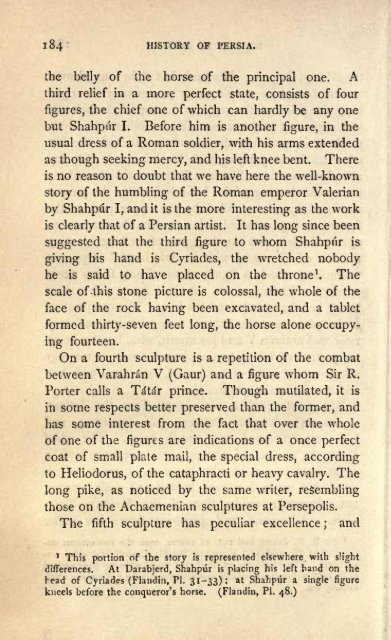Persia from the Earliest Period to the Arab
Persia from the Earliest Period to the Arab
Persia from the Earliest Period to the Arab
Create successful ePaper yourself
Turn your PDF publications into a flip-book with our unique Google optimized e-Paper software.
184 HISTORY OF PERSIA.<br />
<strong>the</strong> belly of <strong>the</strong> horse of <strong>the</strong> principal one. A<br />
third relief in a more perfect state, consists of four<br />
figures, <strong>the</strong> chief one of which can hardly be any one<br />
but Shahpur I. Before him is ano<strong>the</strong>r figure, in <strong>the</strong><br />
usual dress of a Roman soldier, with his arms extended<br />
as though seeking mercy, and his left knee bent. There<br />
is no reason <strong>to</strong> doubt that we have here <strong>the</strong> well-known<br />
s<strong>to</strong>ry of <strong>the</strong> humbling of <strong>the</strong> Roman emperor Valerian<br />
by Shahpur I, and it is <strong>the</strong> more interesting as <strong>the</strong> work<br />
is clearly that of a <strong>Persia</strong>n artist. It has long since been<br />
suggested that <strong>the</strong> third figure <strong>to</strong> whom Shahpur is<br />
giving his hand is Cyriades, <strong>the</strong> wretched nobody<br />
he is said <strong>to</strong> have placed on <strong>the</strong> throne 1<br />
.<br />
The<br />
scale of this s<strong>to</strong>ne picture is colossal, <strong>the</strong> whole of <strong>the</strong><br />
face of <strong>the</strong> rock having been excavated, and a tablet<br />
formed thirty-seven feet long, <strong>the</strong> horse alone occupy-<br />
ing fourteen.<br />
On a fourth sculpture is a repetition of <strong>the</strong> combat<br />
between Varahran V (Gaur) and a figure whom Sir R.<br />
Porter calls a Tdtrfr prince. Though mutilated, it is<br />
in some respects better preserved than <strong>the</strong> former, and<br />
has some interest <strong>from</strong> <strong>the</strong> fact that over <strong>the</strong> whole<br />
of one of <strong>the</strong> figures are indications of a once perfect<br />
coat of small plate mail, <strong>the</strong> special dress, according<br />
<strong>to</strong> Heliodorus, of <strong>the</strong> cataphracti or heavy cavalry. The<br />
long pike, as noticed by <strong>the</strong> same writer, resembling<br />
those on <strong>the</strong> Achaemenian sculptures at Persepolis.<br />
The fifth sculpture has peculiar excellence ; and<br />
1 This portion of <strong>the</strong> s<strong>to</strong>ry is represented elsewhere with slight<br />
differences. At Dnrabjerd, Shahpur is placing his left hand on <strong>the</strong><br />
bead of Cyriades (Flandin, PI. 31-33): at Shahpur a single figure<br />
kneels before <strong>the</strong> conqueror's horse. (Flandin, PI. 48.)

















